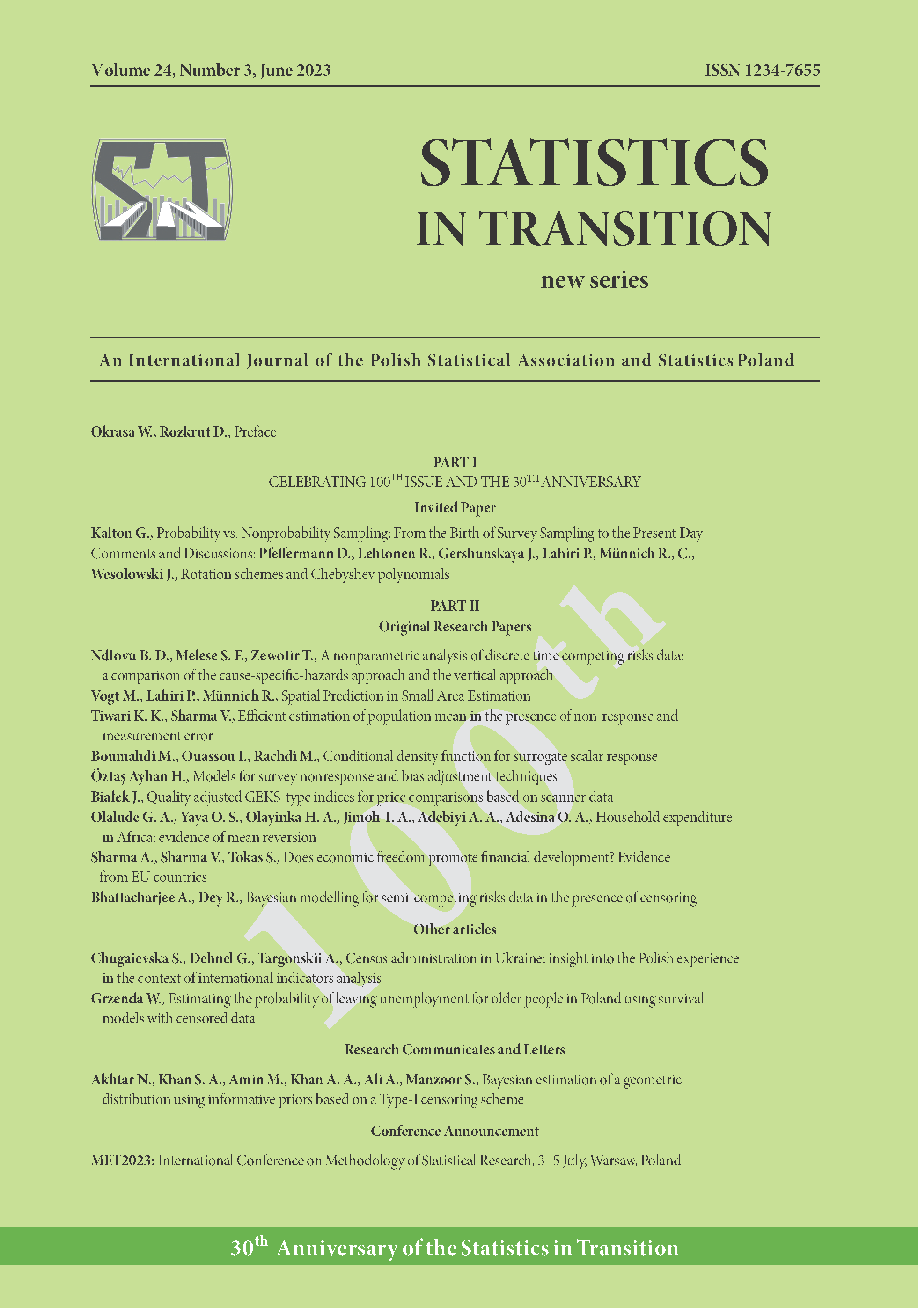ARTICLE
ABSTRACT
Current demographic changes require greater participation of people aged 50 or older in the labour market. Previous research shows that the chances of returning to employment decrease with the length of the unemployment period. In the case of older people who have not reached the statutory retirement age, these chances also depend on the time they have left to retirement. Our study aims to assess the probability of leaving unemployment for people aged 50-71 based on their characteristics and the length of the unemployment period. We use data from the Labour Force Survey for 2019–2020. The key factors determining employment status are identified using the proportional hazard model. We take these factors into account and use the direct adjusted survival curve to show how the probability of returning to work in Poland changes as people age. Due to the fact that not many people take up employment around their retirement age, an in-depth evaluation of the accuracy of predictions obtained via the models is crucial to assess the results. Hence, in this paper, a time-dependent ROC curve is used. Our results indicate that the key factor that influences the return to work after an unemployment period in the case of older people in Poland is whether they reached the age of 60. Other factors that proved important in this context are the sex and the education level of older people.
KEYWORDS
employment, older workers, proportional hazard model, time-dependent ROC curve.
REFERENCES
Aalen, O. O., (1978). Nonparametric inference for a family of counting processes. Annals of Statistics, 6, pp. 701–726.
Batyra, A., Pierrard, O., de la Croix, D. and Sneessens, H. R., (2019). Structural changes in the labor market and the rise of early retirement in France and Germany. German Economic Review, 20(4), pp. e38–e69.
Blackburn, R. M., Jarman, J. and Racko, G., (2016). Understanding gender inequality in employment and retirement. Contemporary Social Science, 11(2-3), pp. 238–252.
Bowman, D., McGann, M., Kimberley, H. and Biggs, S., (2017). ‘Rusty, invisible and threatening’: ageing, capital and employability. Work, employment and society, 31(3), pp. 465–482.
Chang, I. M., Gelman, R. and Pagano, M., (1982). Corrected group prognostic curves and summary statistics. Journal of chronic diseases, 35(8), 669–674.
Charni, K., (2022). Do employment opportunities decrease for older workers? Applied Economics, 54(8), pp. 937–958.
Cox, D. R., (1972). Regression models and life-tables. Journal of the Royal Statistical Society: Series B (Methodological), 34(2), pp. 187–202.
Cox, D.R., Oakes, D., (1984). Analysis of Survival Data. London – New York: Chapman and Hall.
Eurostat, (2022). Employment rates by sex, age and citizenship (%). https://ec.europa.eu/eurostat/databrowser/view/lfsa_ergan/default/table?lang=en
Hairault, J. O., Sopraseuth, T. and Langot, F., (2010). Distance to retirement and older workers‘ employment: The case for delaying the retirement age. Journal of the European Economic association, 8(5), pp. 1034–1076.
Heagerty, P. J., Lumley, T. and Pepe, M. S., (2000). Time-dependent ROC curves for censored survival data and a diagnostic marker. Biometrics, 56(2), pp. 337–344.
Heagerty, P. J., Zheng, Y., (2005). Survival model predictive accuracy and ROC curves. Biometrics, 61(1), pp. 92–105.
Gail, M. H., Byar, D. P., (1986). Variance calculations for direct adjusted survival curves, with applications to testing for no treatment effect. Biometrical Journal, 28(5), pp. 587–599.
Guo, C., So, Y. and Jang, W., (2017). Evaluating predictive accuracy of survival models with PROC PHREG. Paper SAS462-2017, Cary, NC: SAS Institute.
Fleischmann, M., Koster, F. and Schippers, J., (2015). Nothing ventured, nothing gained! How and under which conditions employers provide employabilityenhancing practices to their older workers. The International Journal of Human Resource Management, 26(22), pp. 2908–2925.
Gałecka-Burdziak, E., Góra, M., (2016). The impact of easy and early access to old-age benefits on exits from the labour market: a macro-micro analysis. IZA Journal of European Labor Studies, 5(1), pp. 1–18.
Jansen, A., (2018). Work–retirement cultures: a further piece of the puzzle to explain differences in the labour market participation of older people in Europe? Ageing & Society, 38(8), pp. 1527–1555.
Jarosch, G., (2021). Searching for job security and the consequences of job loss. Working Paper No. 28481, National Bureau of Economic Research. https://www.nber.org/system/files/working_papers/w28481/w28481.pdf
Kamarudin, A. N., Cox, T. and Kolamunnage-Dona, R., (2017). Time-dependent ROC curve analysis in medical research: current methods and applications. BMC medical research methodology, 17(1), pp. 1–19.
Kaplan, E.L., Meier, P., (1958). Nonparametric estimation from incomplete observations. Journal of the American Statistical Association, 53, pp. 457–481.
Nelson, W. (1972). Theory and application of hazard plotting for censored survival data. Biometrics, 14, pp. 945–966.
OECD, (2019). Pensions at a Glance 2019: OECD and G20 Indicators. Paris: OECD Publishing.
Sheldon, G., (2020). Unemployment in Switzerland in the wake of the Covid-19 pandemic: an intertemporal perspective. Swiss Journal of Economics and Statistics, 156(1), pp. 1–9.
Phillipson, C., Vickerstaff, S. and Lain, D., (2016). Achieving fuller working lives: Labour market and policy issues in the United Kingdom. Australian Journal of Social Issues, 51(2), pp. 187–203.
Rutledge, M. S., Sass, S. A. and Ramos-Mercado, J. D., (2017). How does occupational access for older workers differ by education? Journal of Labor Research, 38(3), pp. 283–305.
Torp, C., (Ed.), (2015). Challenges of aging: Pensions, retirement and generational justice. New York: Palgrave Macmillan.
Zhang, X., Loberiza, F. R., Klein, J. P. and Zhang, M. J., (2007). A SAS macro for estimation of direct adjusted survival curves based on a stratified Cox regression model. Computer methods and programs in biomedicine, 88(2), pp. 95–101.
